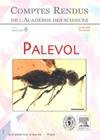高加索和乌拉尔地区洞熊(食肉目,熊科)下门牙的变异
IF 1.3
4区 地球科学
Q3 PALEONTOLOGY
引用次数: 1
摘要
研究了两个不同地理区域(高加索和乌拉尔)、不同地层时期(中更新世和晚更新世)和不同线粒体单倍群(kudarensis (Baryshnikov, 1985)和ingressus Rabeder, Hofreiter & Withalm, 2004)的洞熊下门齿的形态测量学和形态型变异。乌拉尔Ursus kanivetz Vereshchagin, 1973通过上下门牙的形态与高加索U. kudarensis明显区分开来。与高加索洞熊相比,乌拉尔洞熊表现出更多的衍生特征。下颌切牙平均尺寸最大。卡尼维茨狼的下门牙与库达根狼的下门牙明显不同。此外,库达熊的标本也显示出与所有其他洞穴熊群的明显区别。洞熊的门牙形态明显不同于早更新世的U. etruscus G. Cuvier, 1823,也不同于近代的U. arctos L., 1758 (Rabeder, 1999)和U. maritimus Phipps, 1774。研究结果表明,洞熊的门齿具有相似性,表明在洞熊类群谱系中,低食性适应是主要的进化趋势。这些适应特征可能在晚更新世不同穴居熊(U. spelaeus rosenmller, 1794, U. kanivetz和U. kudarensis)谱系中平行发展。本文章由计算机程序翻译,如有差异,请以英文原文为准。
Variability of the lower incisors in the cave bears (Carnivora, Ursidae) from the Caucasus and Urals
Morphometric and morphotypic variability of the cave bear lower incisors from two different geographic regions (Caucasus and Urals), different stratigraphic periods (Middle and Late Pleistocene), and bearing different mitochondrial haplogroups (kudarensis (Baryshnikov, 1985) and ingressus Rabeder, Hofreiter & Withalm, 2004) was studied. Urals Ursus kanivetz Vereshchagin, 1973 is clearly distinguished from Caucasian U. kudarensis by morphology of the upper and lower incisors. The Urals cave bear exhibits more derived features compared to the Caucasian cave bears. Ursus kanivetz exhibits the largest average size of the lower incisors. The lower incisors of U. kanivetz are clearly distinct from those in U. kudarensis. Also, U. kudarensis specimens display a clear separation from all other groups of cave bears. Morphology of the incisors of the cave bears is clearly different from that of Early Pleistocene U. etruscus G. Cuvier, 1823, as well as from that of recent U. arctos L., 1758 (Rabeder, 1999) and U. maritimus Phipps, 1774. Our results suggest that the incisors of the cave bears are similar to each other and demonstrate a hypocarnivorous adaptation as a major evolution trend in the lineage of Spelearctos group. These adaptation features were perhaps developed in parallel in different lineages of the cave bears (U. spelaeus Rosenmüller, 1794 and U. kanivetz on the one hand and U. kudarensis on the other hand) in the Late Pleistocene.
求助全文
通过发布文献求助,成功后即可免费获取论文全文。
去求助
来源期刊

Comptes Rendus Palevol
地学-古生物学
CiteScore
2.10
自引率
0.00%
发文量
39
审稿时长
17.6 weeks
期刊介绍:
Comptes Rendus Palevol is a fully electronic and peer-reviewed journal, with a continuous publication stream, devoted to palaeontology, prehistory and evolutionary sciences. It publishes original research results, in French or English, in the following domains: systematic and human palaeontology, prehistory, evolutionary biology and macroevolution, and history of sciences. Thematic issues may also be published under the responsibility of a guest editor. All articles published in Comptes Rendus Palevol are compliant with the different nomenclatural codes. A copyright assignment will be signed by the authors before publication.
 求助内容:
求助内容: 应助结果提醒方式:
应助结果提醒方式:


